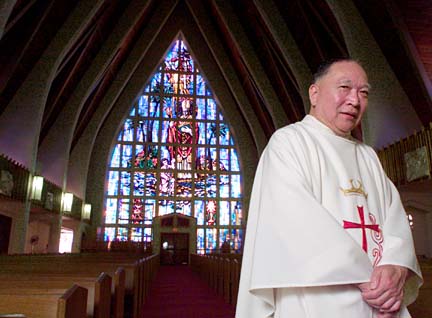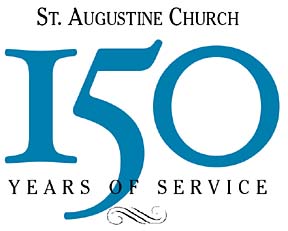

|
View from the Pew Mary Adamski |

|

Early Hawaiian Catholics, who were persecuted,
will be honored at the anniversary celebration
Hawaiian music and dance will be part of the festivities tonight at St. Augustine Church in Waikiki.
It's more than an Hawaiian cultural expression which visitors, who make up 75 percent of people in the pews at any given weekend Mass, might expect at the only Catholic church in Waikiki.
The first Hawaiian Catholics, who were persecuted and punished for practicing their faith, will be honored as the 150th anniversary of the Waikiki church is celebrated at 5 p.m. Mass and a banquet across the street at the Waikiki Beach Marriott Resort.
"We will pay tribute to people who suffered so the church can stand today," said the Rev. Thomas Choo, current parish administrator. Twelve Hawaiian names are listed in tonight's program as the "first confessors" of the parish, but Catholic archives don't show if they were among the early converts who, at the order of Queen Kaahumanu, were arrested, imprisoned and sentenced to the hard labor of collecting rocks and building walls in the unoccupied Waikiki plain.
In an extension of the zeal of the New England Protestant missionaries who arrived the islands in 1820, Kaahumanu drove out the first Catholic missionaries from France five years after their arrival in 1827. The Protestant-vs.-Papist chapter in Hawaii history reflected religious polarization that colored politics in Europe and America for 400 years. It continued here as more subtle social, business and academic discrimination long after King Kamehameha III established freedom of religious expression for all in 1839.
"I think the Hawaiians wanted to know about the world, and here were new arrivals, Europeans, and they wanted to hear them," said Choo, a history buff. He compared them to the Greeks in Athens to whom St. Paul preached and described as "always fond of hearing some new thing."
What Choo, associate pastor the Rev. Mark Consalvi and the 1,200 local members of St. Augustine have focused on for the last couple of years is not the human, spiritual underpinnings of the church, but the structure itself.
It's a landmark, the tall peaked copper roof of the French Gothic building amid the street-level commercial clutter and the high-rise hotels at the Diamond Head end of Kalakaua Avenue. Dedicated in 1962, it is the third permanent structure at the site where the earliest gatherings were in a beachside chapel of palm fronds and driftwood.
It's a work in progress, two years into a $1.8 million reconstruction. "People think concrete is forever," said Choo, but he compares the building to an infected tooth where the extent of damage is revealed under the surface.
Water has seeped inside the walls for years, as drainpipes were unable to handle the torrent rushing down the 70-degree pitch of the roof. Contractors with Smith Hawaii told the parish that if it had continued, the structure would have been unstable within 10 years.
Seashore salt-laden air set off an unplanned repair project in 1999. A steel bar, part of the retaining structure of the 30-foot-tall stained-glass window of St. Augustine, fell to the floor one day. It was a wake-up call about the corrosion undermining the 21 stained glass windows originally crafted in Austria. That main window cost $250,000 to restore, and local artisan Joseph Dwight is completing work on the others.
As Choo worked on his homily for tonight's Mass, he said he wasn't going to dwell on 19th-century persecution or 20th-century corrosion, but on the Gospel reading of the day, which "presents us with the motivation to move on in the 21st century."
The passage concerns a parable that Jesus told about a king who, rejecting his original guests, invited the homeless to his wedding feast.
"God is giving everything, his very blood, to you and not asking questions about where you're coming from," said Choo. "This gospel is one that people hear and don't know what to do with it. For us, gift-giving is gift exchange -- we expect something in return.
"We can't see ourselves doing the same thing; no one is going to invite homeless to your wedding reception.
"The lesson for us is reverence for life, respect for those you are ministering to. If we don't have that, we have arrogance. Your ministry is to love your God and help others love him."
"Remember, Rejoice, Renew" is the underlying theme of the anniversary celebration. Renew refers to a directed spiritual program parishioners will embark on in October, a combination of group discussions, prayer and personal reflection. "There's no sense in having a building if no people are here," said the pastor.
The parable has a special significance for the parish, which is one of the few on Oahu that directly serve the needy and homeless. A long-running program of free hot lunches served five days a week will resume soon, after a hiatus during the construction.
Today is the feast day of St. Augustine, a fifth-century bishop who became one of the greatest Christian theologians after what Choo refers to "life on the other side" -- years with a mistress and a dissolute lifestyle.
A resident of North Africa, Augustine was a "man of color," and it's easy to imagine that the sight of his brown face in the stained-glass window would have struck a chord in the hearts of those first Hawaiian Catholic converts.
Email her at madamski@starbulletin.com.